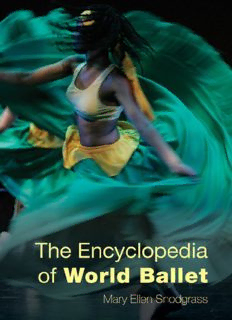
The Encyclopedia of World Ballet PDF
Preview The Encyclopedia of World Ballet
The Encyclopedia of World Ballet The Encyclopedia of World Ballet Mary Ellen Snodgrass ROWMAN & LITTLEFIELD Lanham • Boulder • New York • London Published by Rowman & Littlefield A wholly owned subsidiary of The Rowman & Littlefield Publishing Group, Inc. 4501 Forbes Boulevard, Suite 200, Lanham, Maryland 20706 www.rowman.com Unit A, Whitacre Mews, 26-34 Stannary Street, London SE11 4AB Copyright © 2015 by Rowman & Littlefield All rights reserved. No part of this book may be reproduced in any form or by any electronic or mechanical means, including information storage and retrieval systems, without written permission from the publisher, except by a reviewer who may quote passages in a review. British Library Cataloguing in Publication Information Available Library of Congress Cataloging-in- Publication Data Snodgrass, Mary Ellen. The encyclopedia of world ballet / Mary Ellen Snodgrass. pages cm Includes bibliographical references and index. ISBN 978-1-4422-4525-9 (hardback : alk. paper) — ISBN 978-1-4422-4526-6 (ebook) 1. Ballet— Encyclopedias. I. Title. GV1585.S66 2015 792.8—dc23 2014049730 ™ The paper used in this publication meets the minimum requirements of American National Standard for Information Sciences—Permanence of Paper for Printed Library Materials, ANSI/NISO Z39.48-1992. Printed in the United States of America For dance master Louis Nunnery and ballet buddy Kathleen Lilly. We miss you. Contents Contents Preface Acknowledgments Introduction Chronology A B C D E F G H I J K L M N O P R S T U V W Bibliography About the Author Preface The Encyclopedia of World Ballet surveys dance art from social occasions at the court of Louis XIV to current venues in myriad countries, from Cyprus to Singapore. To enlighten the dancer, choreographer, student, teacher, and arts historian, 170 major entries reveal the nature and purpose of ballet. Data include leaders in dance design and style, influential ballet companies, and trends in the development of staging, costuming, and set design by such creators as George Balanchine, Erté, and Inigo Jones. Entries summarize public response to repertoires and to the symbolism of worship dance, Anacreontic and story ballet, and the universal favorites—Swan Lake, Coppélia, The Nutcracker, and The Sleeping Beauty. Research reveals the social and political ramifications of arts controversies over gay ballet, Fascist and Islamic censorship, and arts propaganda under the Communist regimes of the Soviet Union, Cuba, and China. Headwords include topics such as dance essentials (eurythmics, character role, technique, terminology), pedagogues (Enrico Cecchetti, Agrippina Vaganova, Martha Graham, Jules Perrot), and styles (mime, ballet d’action, en pointe, pas de deux, divertissement). Biographies cover choreographers (Michel Fokine, Gerald Arpino, Marius Petipa), dancers (Rudolf Nureyev, Maria Tallchief, Christian Johansson), and innovators (Nacho Duato, Twyla Tharp, Paul Taylor, Amalia Hernández Navarro). There are also overviews of significant Asian (Vietnam, Korea, Siberia, Guangzhou, Iranian, Shanghai, Tokyo) and Pacific companies (Australian, Royal New Zealand, Philippines), African ensembles (Joberg, Cape Town, Cairo), European performers (Greek, Polish, Swedish, Kiev, Netherlands, Finnish, Swedish), and North American troupes (Winnipeg, Washington, Boston, San Francisco, Houston, New York City). The complete A to Z encompasses contrasts and similarities of training, programming, and tours. Blended artistries of such performers as Maurice Béjart, Carmen De Lavallade, and August Bournonville disclose efforts to broaden dance with ethnic elements, an asset of jazz ballet, Universal Ballet, folkloric ballet, Apsara dance, and hybrid ballet. Historical details (Erté, Pierre Beauchamp, Dance Magazine, Alexander Gorsky) orient the reader amid trends (Renaissance dance, polonaise, pas de deux, neoclassical ballet, romantic dance). Specifics of the early twentieth century (Vaslav Nijinsky, Ballet Russe de Monte Carlo, Sergei Diaghilev, Isadora Duncan) account for emerging modernism and efforts at racial integration by Birgit Cullberg, Lester Horton, Judith Jamison, Alicia Alonso, and Alvin Ailey. Classic dances (The Lady of the Camellias, Eugene Onegin, Don Quixote) share space with less common works (Fall River Legend, Spartacus, Totentanz) and specific venues (Paris Opera Ballet, La Scala Theatre Ballet, Moulin Rouge). Peripheral subjects (opéra-ballet, ballet in art and film, choreography, ballet attire and shoes, barre warm-up) fill in particulars essential to an understanding of people and movements—for example, Mikhail Baryshnikov’s contributions to dance cinema, Margot Fonteyn’s interest in spreading the arts to underserved populations, archivists’ collections of specific works with Benesh notation, Marie Camargo’s alterations to professional shoes, and public debuts of promising members of juvenile companies. For visual illustration, the text features photos from a variety of ensembles, including Ballet Kelowna, Compañia Nacional de Danza in Madrid, Estonian National Opera, Royal New Zealand Ballet, School of Dance in Ottawa, Dancecyprus, and Sofia Ballet. Completing the ballet reference source, a timeline orders events from Cambodia’s Angkor Wat in 802 CE to the pastoral traditions of Acis and Galatea reprised in summer 2014 by the Mark Morris Dance Company. Signal achievements range from the introduction of comédie-ballet, temps lie, gas lighting, and female membership in all-male casts to the creation of the Basque entrechat-deux, the defection of Serge Lifar from Russia, and Nikolai Sergeyev’s rescue of classic Russian choreography. The time span preceding and encompassing World War II illustrates the impact of the Nazi high command on Czech performances, the value of Cinderella as a protest of Stalinism, and the loss of Viennese dancers to the Holocaust. A note on artistic freedom legitimates the work of Nima Kiann in Sweden to reclaim Iranian dance tradition. The resurgence of interest in satiric and humorous ballet fills entries on Matthew Bourne and Les Ballets Trockadero de Monte Carlo. A comprehensive index of primary and secondary topics covers major essays on Zoltán Nagy, Mats Ek, and the Hong Kong Ballet along with clarifying and contributive elements: Concepts: neoromanticism, dram-balet, fusion dance, ballet contemporain, puppetry, flamenco, ballet-féerie, eukinetics, social dance, intermedio People: Coco Chanel, Marie Guimard, Suzanne Farrell, Julia Pak Moon, Judith Jamison, Ali Pourfarrokh, Igor Stravinsky, Nejad Ahmadzadeh,
Description: